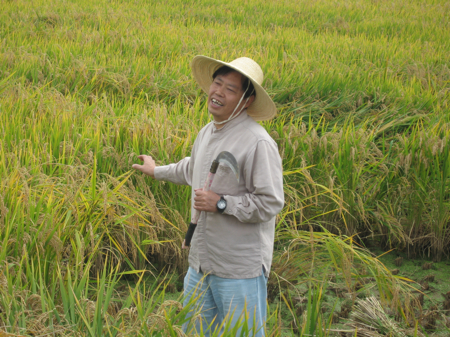Emeka Okafor over at Timbuktu Chronicles points to a blog that sounds really fascinating: BetumiBlog. Betumi is the African Culinary Network. It “connects anyone who delights in African cuisine, foodways, and food history.” BetumiBlog is run by Fran Osseo-Asare, who is clearly incredibly knowledgeable and enthusiastic about African food and cooking. She has contributed a chapter on Food and Foodways to the Sub-Saharan Africa volume of The Greenwood Encyclopedia of World Popular Culture 1. That includes a very useful table summarizing the many different ways Africans prepare their starchy staples. My personal score is nine.
Quemada!
Jeremy asked recently whether shifting agriculture 2 can really support growing populations. I’ve just come across (via the PLEC newsletter) a paper from Madagascar 3 which says maybe.
Its objectives
were to analyze jointly with the Betsimisaraka farmers how slash-and-burn practices influence fallow species succession, and how current fallow/cropping regimes influence agricultural productivity and upland degradation dynamics.
The researchers conclude, from discussions with farmers and botanical surveys, that fallow periods have been cut by up to two thirds — to 3-5 years — in the past 30 years. This means that fallow land goes from having plentiful pigeon wood trees on it to bare, dry unproductive grassland in 5-6 rice cropping cycles, after which agriculture is no longer possible. After each cycle, the land needs to be left fallow for increasing lengths of time in order for the soil to recover fertility: “already with the third cycle after deforestation, vegetation starts to degrade quickly in parallel with agricultural productivity decline.”
The findings of this paper indicate that the tavy system with its currently short fallow periods is collapsing.
The main culprit is fire. As fallows become more herbaceous, fire is more difficult to control, and wildfires escape more easily, often “eliminating a productive plot of land for agriculture without getting any benefits of production.”
So what can be done? Try to take fire out of the equation, certainly. “The restoration of soil fertility should build on the biological potential of the system, by optimizing nutrient cycling (e.g. through residue and weed recycling, mulching) and by producing and recycling of high quality organic matter (e.g. through improved fallows and cover crops).” The key to the adoption and success of these practices will be engagement with the young, according to the authors:
The careful development of alternative agricultural practices should especially be done in collaboration with young farmers. If the young obtain a real interest in agricultural intensification, they may not feel the need anymore to leave their native villages and migrate to the forest border to undertake tavy.
Cheese and olives
A column in the current issue of The Economist uses the example of Gruyère and Emmental cheeses in Switzerland to make the case that, if Europe wants to protect its traditional farmers and producers — and the agrobiodiversity which underpins their livelihoods — in the face of globalization, moving upmarket and selling expensive niche products to rich foreigners may be a better bet than “to deploy subsidies and tariffs to compete artificially on price.” Which is mostly what’s happening now.
[EU farm Commissioner] Mariann Fischer Boel … has urged food producers to focus on quality, heritage and new markets. This summer, she told exporters that import tariffs will move in only one direction in the coming years: “downwardsâ€.
Of course, that will require marketing savvy. It will also require a robust quality-monitoring and labelling systems. Because, as a New Yorker piece on the “slippery business” of trading in fake Italian extra virgin olive oil entertainingly demonstrates this week, there are plenty of wise guys around ready to exploit loopholes and weaknesses.
Later: Cheese, olives, and wine!
More rice terrace wonders
Also at Yunnan Agricultural University I got a brief glimpse of some absolutely fascinating research from the Yuanyang rice terraces, which rival those of Banaue in age and extent. Professor Wang Yunyue, who just happens to be the wife of Professor Zhu, has been studying the agriculture of the Hani people who have cultivated the terraces for at least 1300 years. Modern hybrids have been introduced from time to time, but the Hani always abandon them after a couple of years, usually because they are no longer resistant to the diseases they were brought in to combat. Instead, the Hani continue to grow their traditional landraces.
Feet of clay

That’s another one to tick off the life list. Above you see Zhu Youyong, who describes himself as a farmer. He happens also to be Distinguished Professor Zhu, President of Yunnan Agricultural College and a hero of mine.
Zhu’s name is associated with a method of growing rice that delivers higher, more stable yields with lower inputs of fungicides and a more stable harvest from year to year. Not bad for an amazingly simple idea. The problem is that traditional landraces of sticky rice, which farmers like to grow and to eat, are susceptible to fungal disease. They also have a nasty tendency to fall over, or lodge, especially when they are carrying a bountiful load of seed. Modern hybrids are disease resistant, and high-yielding, but the taste is not much to write home about. Yields are high, but prices are low. To grow the tasty traditional landraces, farmers need to be able to afford fungicides and they need to be able to overcome their tendency to lodge.